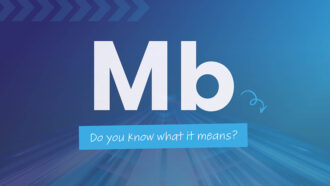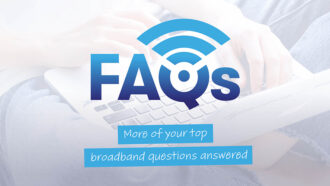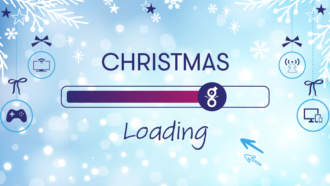Your guide to getting online
Get online with all the information you need This ‘Get Online Week’. We’re here with a breakdown of the techy terms you hear day to day, to help you embrace life online.
14th October 2024
Get online with all the information you need This ‘Get Online Week’. We’re here with a breakdown of the techy terms you hear day to day, to help you embrace life online.
1. ISP (internet service provider): First things first. Your internet service provider or ISP is the company that delivers the internet connection to your home or business. Different ISPs deliver different levels of service and offer different benefits – whether around price, speed or customer support – so it’s important to do your research before committing to a contract.
For example, some ISPs build their own network (like us!), meaning they have more control over their pricing. For us, we pride ourselves on fair and transparent pricing and, with full control over our network, we’re able to pass on amazing prices and savings to our customers. On the other hand, some providers rent lines from resellers like Openreach – meaning their prices are driven by the overheads of another company. Keep reading to find out more about the different kinds of broadband available on the market.
2. Fibre-to-the-Property or FTTP (aka Full Fibre – like ours!): Full Fibre broadband provides an internet connection using fibre-optic cables that run directly to the router in a user’s home or business. This technology offers ultra-fast and reliable internet speeds by transmitting data as pulses of light through these fibres, delivering some of the highest internet speeds available on the market, today.
3. Fibre-to-the-Cabinet or FTTC: These networks are slower, using fibre-optic cable to connect the street cabinet to the internet, but relying on traditional copper cable for the last-mile connection (from the street cabinet to the user’s home or business). This drastically slows your speeds!
4. Exchange-only-line or EOL: This is a copper system that transmits data through electrical signals, resulting in slower speeds and higher lag. These are often older lines that were installed before fibre-optic technology became available.
5. Fibre-optic cable: Fibre optic is essentially strands of optically pure glass that transmit data as pulses at the speed of light – literally lightning fast! With a Grain connection, you get a dedicated fibre-optic cable that you don’t have to share with your neighbours – meaning better speeds and reliability, all for you!
6. Data is the information that is transmitted via your broadband in the form of ‘bits’. Bits are usually used to measure connection speed, normally in the form of megabits, there are 8 million bits in one-megabyte, crazy right?
7. Mbps vs. Gbps: Mbps (Megabits per second) and Gbps (Gigabits per second) represent different levels of data transfer speeds:
Mbps or Mb: Mbps is a unit of measurement for internet or data transfer speeds. It equals one million bits per second. Mbps is commonly used for residential internet connections and represents moderate to high-speed internet, suitable for web browsing, streaming, and most online activities.
Gbps or Gb: Gbps is a unit of measurement for extremely high-speed data transfer. It equals one billion bits per second, which is significantly faster than Mbps (1000Mbps = 1Gbps). Gbps is typically used in enterprise-level networks, data centres, and advanced applications like 4K/8K video streaming, high-performance computing, and large-scale data transfers.
In short, Mbps is used for everyday internet speeds, while Gbps represents much faster and more robust data transfer rates used in professional and high-demand environments.
8. Bandwidth: The more bandwidth you have, the more data your devices can use at once! The bandwidth refers to the data transmission capacity of an internet connection. This is typically measured in megabits per second (Mbps) or gigabits per second (Gbps). It determines how much data can be transmitted over the network at a given time, impacting internet speed and the ability to handle multiple online activities.
So, the better the bandwidth, the better the connection and speeds you’ll receive. There are also some factors that may impact your bandwidth like network congestion, your internet service plan, the physical distance of the internet cable and sometimes the quality of your router.
9. Online traffic: Traffic is the number of users and/or devices on a broadband network at one time. Much like traffic on the roads, the more you have, the slower your connection goes. At Grain, you can stay in the fast lane, as we install a dedicated fibre cable to the router in your home or business.
10. Upload & download speeds:
Upload – Sending data from your device to the internet, like when you post a photo or send an email.
Download – Download is like receiving a digital care package from the internet, getting all the cool stuff you want – movies, music, and more!
Unlike some providers that don’t prioritize fast upload speeds, Grain takes a unique approach. With us, you get symmetrical download and upload speeds. Whether you’re streaming, engaging in video conferencing, or gaming online, these balanced speeds are what ensure the robust stability of your connection.
11. Latency (Ping): Latency, often measured as “ping,” is the delay or response time in milliseconds (ms) it takes for data to travel between a source (like a computer or server) and a destination over a network. Lower latency values indicate quicker data transmission and are critical for real-time applications like online gaming and video conferencing.
12. IP address: (basically a postcode for your broadband) The location of your laptop, tablet, or phone when it’s online, but in number form. IP addresses are important because they serve as unique identifiers for devices on the internet, enabling data routing and communication, allowing devices to find and connect with each other, improving cyber security and facilitating the functioning of the internet as a global network.
13. Firewall (Like a bouncer at a nightclub): Most modern devices now include built-in firewalls, they keep out unwanted guests (like viruses and hackers) while letting in the cool, safe stuff (like cat videos and social media updates). A firewall is a network security device or software that monitors and controls incoming and outgoing network traffic based on predefined security rules. Although firewalls are not compulsory to have, it’s considered safe practice to take extra security steps to shield your devices from cyber criminals.
14. VoIP or Voice over Internet Protocol: Instead of using traditional phone lines, VoIP uses the internet to let you chat, gossip, and stay connected with your friends and family, no matter where they are in the world! Need a phone line? Our digital phone packages are an optional extra, so you can tailor your package to suit your needs – plus, we don’t charge line rental! Find our more.
15. Ethernet cable: Using an Ethernet cable instead of wi-fi provides a faster, more stable, and secure internet connection with lower latency and reduced interference. In contrast, wi-fi is susceptible to signal fluctuations, congestion, and potential security vulnerabilities. This makes Ethernet a preferred choice for bandwidth-intensive tasks and environments with larger coverage areas. You should consider connecting devices that require the most bandwidth like desktop computers, gaming consoles and Smart TVs with an Ethernet cable. See our FAQs for more on how to get the most out of your speeds.
Any questions? The internet harbours endless opportunities, from online learning and working from home, to staying connecting with loved ones, and indulging in epic entertainment. If you’re struggling to navigate the digital world, we’re here to help. Check out our FAQs for more information or get in touch to speak to one of our broadband experts.
Get Online Week is an annual campaign hosted by leading digital inclusion charity Good Things Foundation, who power the National Device Bank, National Databank, Learn My Way and the National Digital Inclusion Network.
Share this article
Related Articles

Tech Tips | Apr 6, 2025
The Ultimate Guide to Broadband Speeds

Tech Tips | Feb 19, 2025
More of your burning broadband questions

Tech Tips | Dec 22, 2024

